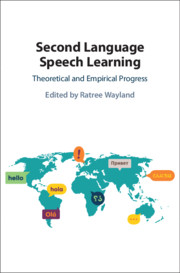Book contents
- Second Language Speech Learning
- Second Language Speech Learning
- Copyright page
- Dedication
- Contents
- Figures
- Tables
- Contributors
- Preface
- Acknowledgments
- Part I Theoretical Progress
- Chapter 1 The Revised Speech Learning Model (SLM-r)
- Chapter 2 The Revised Speech Learning Model (SLM-r) Applied
- Chapter 3 New Methods for Second Language (L2) Speech Research
- Chapter 4 Phonetic and Phonological Influences on the Discrimination of Non-native Phones
- Chapter 5 The Past, Present, and Future of Lexical Stress in Second Language Speech Production and Perception
- Part II Segmental Acquisition
- Part III Acquiring Suprasegmental Features
- Part IV Accentedness and Acoustic Features
- Part V Cognitive and Psychological Variables
- Index
- References
Chapter 5 - The Past, Present, and Future of Lexical Stress in Second Language Speech Production and Perception
from Part I - Theoretical Progress
Published online by Cambridge University Press: 21 January 2021
- Second Language Speech Learning
- Second Language Speech Learning
- Copyright page
- Dedication
- Contents
- Figures
- Tables
- Contributors
- Preface
- Acknowledgments
- Part I Theoretical Progress
- Chapter 1 The Revised Speech Learning Model (SLM-r)
- Chapter 2 The Revised Speech Learning Model (SLM-r) Applied
- Chapter 3 New Methods for Second Language (L2) Speech Research
- Chapter 4 Phonetic and Phonological Influences on the Discrimination of Non-native Phones
- Chapter 5 The Past, Present, and Future of Lexical Stress in Second Language Speech Production and Perception
- Part II Segmental Acquisition
- Part III Acquiring Suprasegmental Features
- Part IV Accentedness and Acoustic Features
- Part V Cognitive and Psychological Variables
- Index
- References
Summary
This chapter provides a critical review of the research on L2 learners’ lexical stress production and perception conducted over the past three decades, which has sought to explain cross-linguistic variability in L2 learners’ ability to reach target-like generalizations in their stress placement and to encode stress lexically. The chapter begins with a discussion of generative approaches to the study of lexical stress in L2 learners, which focused on the influence of the native-language (L1) phonological grammar on L2 learners’ stress placement. These approaches were subsequently challenged by the seminal work of Susan Guion and colleagues, which examined the influence of statistical regularities on L2 learners’ (and native speakers’) stress placement in novel words. The chapter then discusses phonological approaches to L2 learners’ perception and processing of lexical stress, focusing on Peperkamp and Dupoux (2002)’s Stress Parameter Model and the predictions it made for the encoding of stress in lexical representations by listeners from different L1 backgrounds. These approaches were later refined in studies investigating the importance of phonetic cues to lexical contrasts in the L1 for determining whether L2 learners can perceive lexical stress. The chapter concludes with directions for future research on L2 lexical stress.
Information
- Type
- Chapter
- Information
- Second Language Speech LearningTheoretical and Empirical Progress, pp. 175 - 192Publisher: Cambridge University PressPrint publication year: 2021
